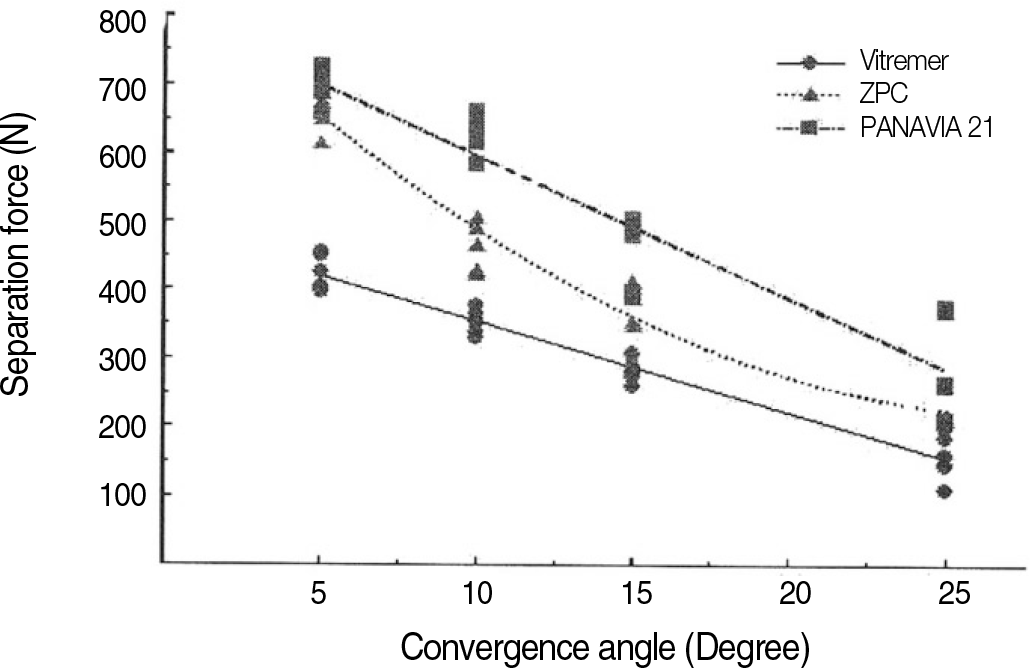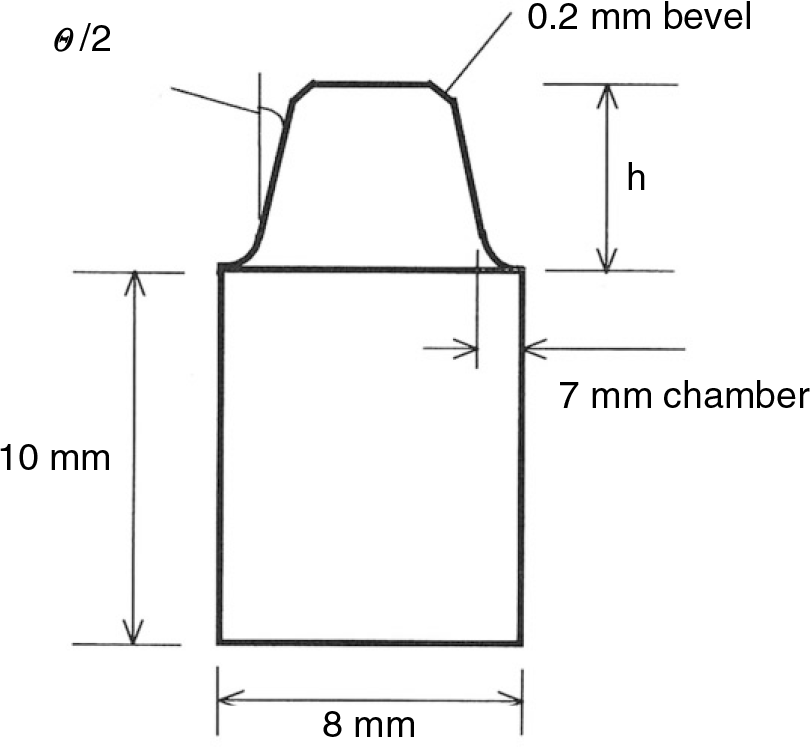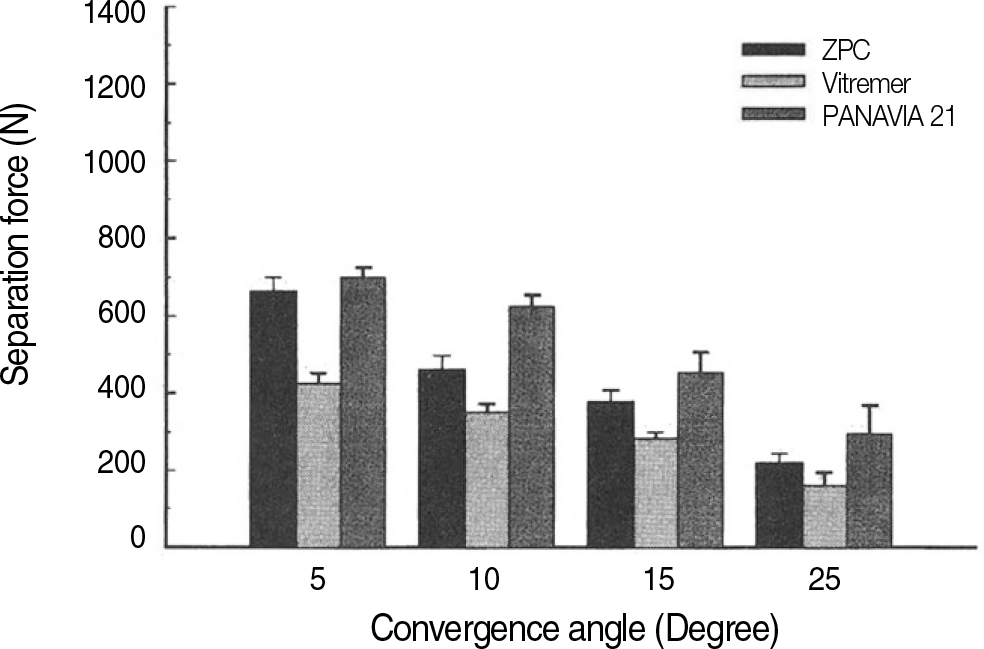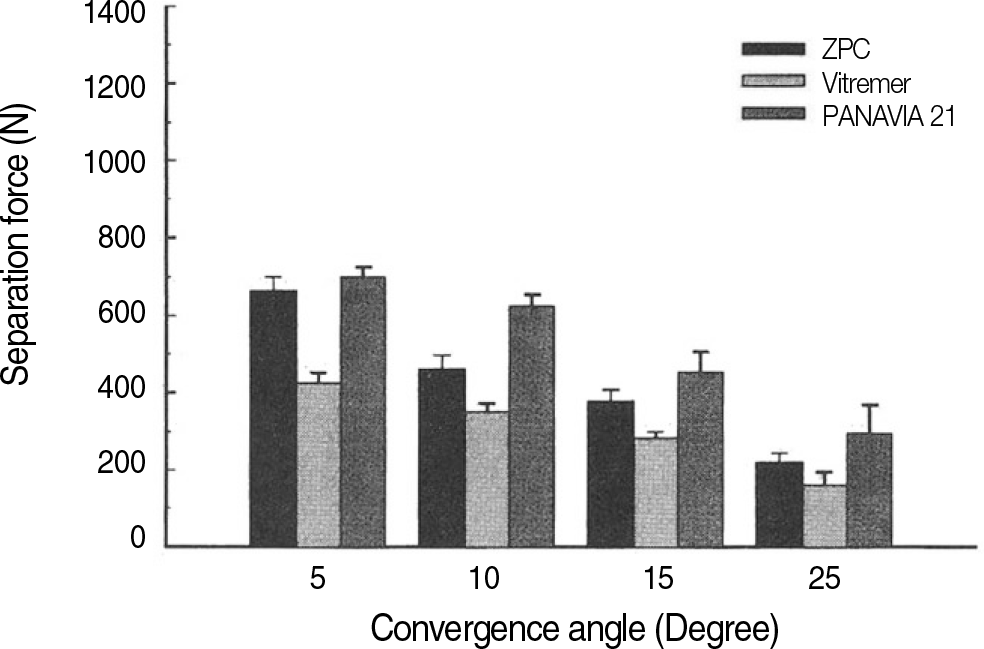Abstract
Purpose
The aim of this research was to establish the effect and variation in differing convergence angle and length of abutment on the retention of full veneer casted gold crown.
Materials and methods
Two different length,5 mm and 10 mm in height with convergence angles of 5, 10, 15 and 25 degrees crowns were fabricated. Cementation was done using cements; zinc phosphate cement (Fleck's zinc phosphate cement), resin-modified glass ionomer cement (Vitremer) and resin cement (Panavia 21). These were tested for tensile force at the point of separation by using Instron Universal Testing Machine. Statistical analysis was done by SAS 6.04 package.
Results
In all cements the mean retention decreased with significant difference on increase of convergence angle (P<.05). Increase in every 5 degree-convergence angel the retention rate decreased with resin-modified glass ionomer cement of 15.9% and resin cement of 14.8%. With zinc phosphate cement, there was largest decreasing rate of mean retention of 25.5% between convergence angles from 5 degree to 10 degree. When the crown length increased from 5 mm to 10 mm, the retention increased with the significant difference in the same convergence angle and in all types of cement used (P<.05).
Go to : 
REFERENCES
1.Walton JN., Gardner FM., Agar JR. A survey of crown and fixed partial denture failures: length of service and reasons for replacement. J Prosthet Dent. 1986. 56:416–21.

2.Paek SH., Chang IT., Lee SH., Yang JH., Heo SJ. A study of core type and luting cements on complete cast crown retention. J Korean Acad Prosthodont. 2000. 38:169–77.
3.J⊘rgensen KD. The relationship between retention and convergence angle in cemented veneer crowns. Acta Odontol Scand. 1955. 13:35–40.
4.Shillingburg H., Shillingburg HT. Fundamentals of fixed prosthodontics. 2nd ed.Chicago, Quintessence Publishing Co.;1981.
5.Nordlander J., Weir D., Stoffer W., Ochi S. The taper of clinical preparations for fixed prosthodontics. J Prosthet Dent. 1988. 60:148–51.

6.Ayad MF., Rosenstiel SF., Salama M. Influence of tooth surface roughness and type of cement on retention of complete cast crowns. J Prosthet Dent. 1997. 77:116–21.

7.Tuntiprawon M. Effect of tooth surface roughness on marginal seating and retention of complete metal crowns. J Prosthet Dent. 1999. 81:142–7.

8.Wilson AD., Kent BE. A new translucent cement for dentistry. The glass ionomer cement. Br Dent J. 1972. 132:133–5.

9.Mathis RS., Ferracane JL. Properties of a glass-ionomer/resin-composite hybrid material. Dent Mater. 1989. 5:355–8.

10.el-Mowafy OM., Fenton AH., Forrester N., Milenkovic M. Retention of metal ceramic crowns cemented with resin cements: effects of preparation taper and height. J Prosthet Dent. 1996. 76:524–9.

11.Pameijer CH., Jefferies SR. Retentive properties and film thick- ness of 18 luting agents and systems. Gen Dent. 1996. 44:524–30.
12.Ernst CP., Wenzl N., Stender E., Willershausen B. Retentive strengths of cast gold crowns using glass ionomer, compomer, or resin cement. J Prosthet Dent. 1998. 79:472–6.

13.Rosenstiel SF., Land MF., Crispin BJ. Dental luting agents: A review of the current literature. J Prosthet Dent. 1998. 80:280–301.

14.Black SM., Charlton G. The retention of gold crowns on human dentine preparations-a comparison of eight cements. Restorative Dent. 1989. 5:39–41.
15.Caughman WF., O'Connor RP., Williams HA., Rueggeberg FA. Retention strengths of three cements using full crown preparations restored with amalgam. Am J Dent. 1992. 5:61–3.
16.Gorodovsky S., Zidan O. Retentive strength, disintegration, and marginal quality of luting cements. J Prosthet Dent. 1992. 68:269–74.

17.Mojon P., Hawbolt EB., MacEntee MI., Ma PH. Early bond strength of luting cements to a precious alloy. J Dent Res. 1992. 71:1633–9.

18.Tjan AH., Li T. Seating and retention of complete crowns with a new adhesive resin cement. J Prosthet Dent. 1992. 67:478–83.

19.Kanoy BE., Felton DA., White JT., Bayne C. Effects of the porcelain firing sequence on the bond strengths of cements. J Oral Rehabil. 1989. 16:335–43.

20.Oilo G. Luting cements: a review and comparison. Int Dent J. 1991. 41:81–8.
21.Potts RG., Shillingburg HT Jr., Duncanson MG Jr. Retention and resistance of preparations for cast restorations. J Prosthet Dent. 1980. 43:303–8.

22.Rosenstiel SF. LM, Fusimoto J. Contemporary fixed prosthodontics. 2nd ed.St. Louis: Mosby;1995.
23.Tylman SD. Relationship of structural design of dental bridges and their supporting tissues. Int Dent J. 1963. 13:303–17.
24.Tylman SD. Theory and practice of fixed prosthodontics. 7th ed.St Louis: CV Mosby Company;1978.
25.Weed RM., Suddick RP., Kleffner JH. Taper of clinical and typodont crowns prepared by dental students. J Dent Res. 1984. 63:286.
27.Gregory WA., Griffiths L., Irwin G. Effects of intra-core mechanical interlocks and cement type on full crown retention. Am J Dent. 1991. 4:29–32.
28.Xavier CRG. Countinho M, Mondelli J. Punch strength of luting agents by punch test. J Dent Res. 1997. 76:451.
Go to : 
 | Fig. 3.Regression analysis model of cement groups. (Length 5 mm) Equation - Fleck's ZPC: y = 861.1 - 45.24x + 0.7922x2 - Vitremer: y = 486.796 - 13.2328x - Panavia 21: y = 803.565 - 20.7705x |
Table 1.
Dental cements used in this study
Table 2.
Mean values and standard deviations of separation forces (N) of length 5 mm
Table 3.
Turkey's HSD test for variable: separation force (N)
| Cement | Angle's section | 5° -10° | 10° -15° | 15° -25° |
|---|---|---|---|---|
| Fleck's ZPC | ∗∗∗ | ∗∗∗ | ∗∗∗ | |
| Vitremer | ∗∗∗ | ∗∗∗ | ∗∗∗ | |
| Panavia 21 | ∗∗∗ | ∗∗∗ |
Table 4.
Mean value and standard deviations of separation force (N) of length 10 mm




 PDF
PDF ePub
ePub Citation
Citation Print
Print





 XML Download
XML Download